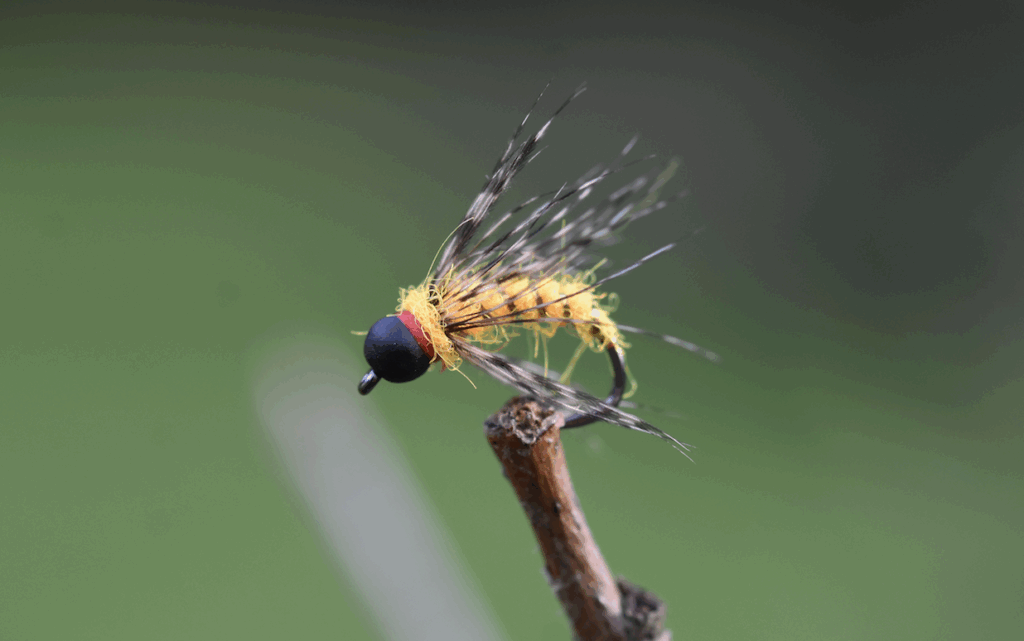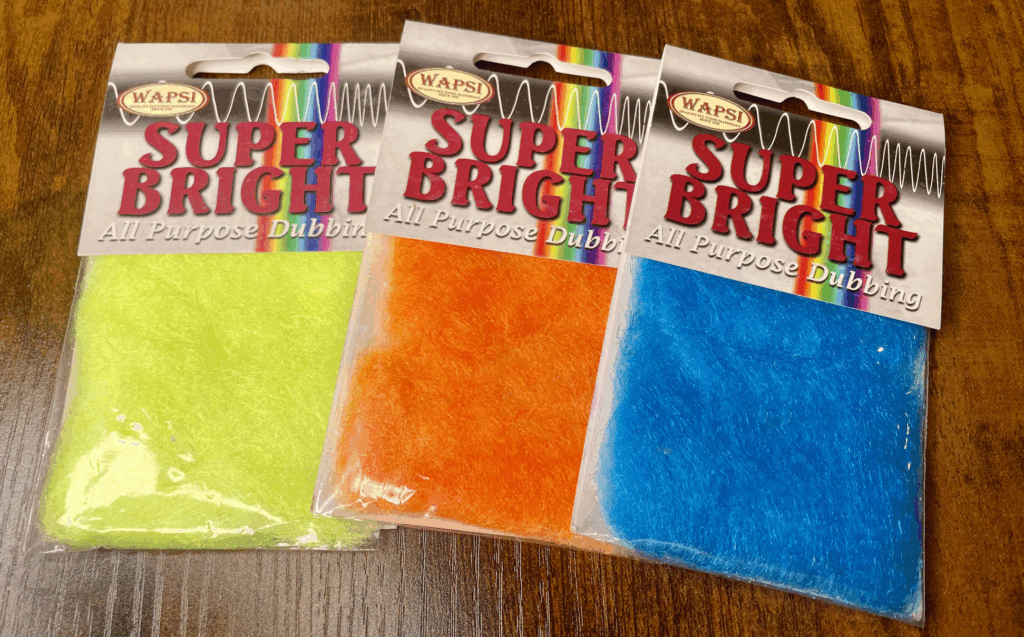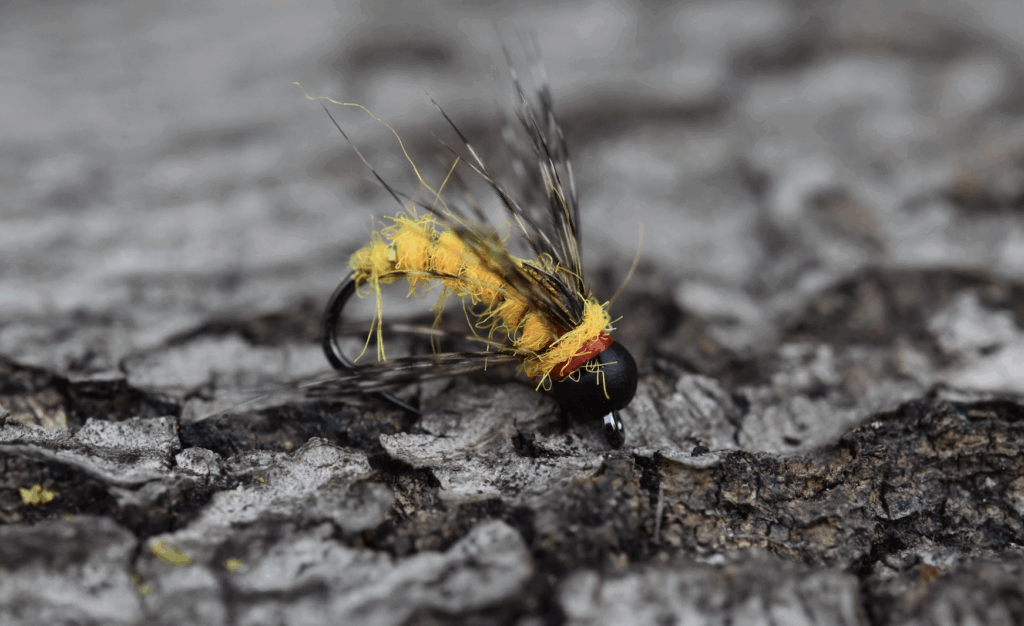Fishing and Tying the Super Bright October Caddis

I love experimenting with new materials, so when I saw a pack of Wapsi Super Bright Dubbing on the rack at a local fly shop, I couldn’t resist adding a pack (or two…or three!) to my purchase. I ended up with fluorescent orange, fluorescent yellow, and fluorescent blue. These are all part of Wapsi’s line of steelhead colors for this dubbing, but my intention was to tie trout nymphs and wet flies with them.
The first pattern I tied with this new material is what I called a Super Bright October Caddis. I tied it specifically for fishing a certain stream that has tannic-colored water. It’s an AMD recovered waterway that flows through an industrialized area and receives several discharges from factories that stain the water pretty good. Big browns live there, though, and experience has taught me that they’re suckers for bright-colored flies.
No surprise, the first trip with my new Super Bright October Caddis proved fruitful. I fished all morning with my usual patterns and landed a few, but things really heated up once I tied on the caddis. A half dozen trout hit the net and I lost a really nice 16-incher before losing both samples I’d tied for the trip.

Fishing the Super Bright October Caddis
I call this pattern an October Caddis because I used fluorescent orange Super Bright Dubbing for the body. October Caddis generally have a burnt-orangish body, so I looked at this pattern as a more vibrant variation of the natural.
Don’t let the name fool you, though. This nymph catches fish all months of the year, not just during the fall. In fact, it’s become a staple in my fly box through all seasons. But there are a few times when I specifically turn to this pattern:
- In the fall…obviously…when October Caddis are most active. I’ve come to view this pattern as a “supercharged” October Caddis imitation. The Hungarian partridge hackle has nice movement in the water and can trigger strikes when nothing else will. In fact, I incorporate soft hackle into most of my caddis imitations for this reason: trout sometimes feed more on caddis subsurface than they do on top, even when there are a lot of caddis hatching. (Here’s an article I wrote about “Fishing Caddisflies Top to Bottom” that talks more about this.)
- As mentioned previously, in streams and rivers that have tannic-colored water. Sometimes it’s from industrial discharge, sometimes its other environmental factors, and occasionally it’s just natural factors that give these waters their distinct tea color. Whatever the reason, bright-colored flies of all types seem to work exceptionally well in these waters.
- When I need a fly that’s visible in certain water conditions. These can vary, of course, depending on flows and clarity, but a cool trick I learned is to stick the fly in the water and see how it looks at certain depths. If the trout can’t see it, there’s a good chance they’re not going to eat it. That goes with any fly pattern, not just this one.
- When trout are keying on emergers or food that’s higher up in the water column. In these instances, any soft-hackled fly such as the Super Bright October Caddis is a good choice. You could even tie with pattern with different-colored bodies to imitate a wider variety of insects.
Materials Needed to Tie the Super Bright October Caddis
Hook: Size 14 Fulling Mill Czech Nymph
Bead: 1/8 Matte Black Tungsten Bead
Thread: 8/0 Red Classic Waxed Semperfli
Ribbing: Mirror Flash in Black Peacock or you can use a Flashabou substitute such as the Holographic Flashabou
Body and Thorax: Wapsi Super Bright in Fl. Orange, or you can use the NS Emergence Dubbing in Caddis Orange
Hackle: Whiting Coq De Leon Hen Saddle in Speckled Brown, or Hungarian Partridge if you prefer
Watch Video of Tying this Pattern
Tying Tips for the Super Bright October Caddis
Slide a black matte bead onto the hook and secure in your fly tying vise. I prefer the dark bead because of the contrast it provides with the bright body, but you could also tie this pattern with gold, copper, or silver beads and catch fish. I have noticed, though, that the black bead is absolutely more productive when water is low and clear, which it usually is during the fall months.
I use red thread to tie this fly, also because of the contrast it provides. I’m a firm believer that any contrast added to a pattern is a good thing, and red is a well-know “trigger” color for trout. Attach the thread and wrap it to the rear of the hook, stopping above the bend.
Tie in a strand of your ribbing of choice. The black peacock Mirror Flash provides more distinct body segmentation and adds a little darker color. This is my preferred ribbing material, but if that’s not available, I also use a strand of Flashabou.
Pinch a sparse amount of fluorescent orange Wapsi Super Bright Dubbing onto the thread and create a thin dubbing noodle. This dubbing is a little coarse and produces a shaggy looking body that is very buggy in appearance. Use touching wraps to advance the dubbing toward the bead, but leave a small gap between the body and bead to allow room for the hackle and collar. Sometimes I even make the thorax part of this fly a little bulkier; this allows the hackle collar to flare out and gives the fly a little more action in the water.
Select a Hungarian partridge feather and tie in by the tip. I like a feather that had fibers long enough so that the tips reach back almost to the hook bend. You could also use natural CDC for the collar or hen saddle. Any soft feather is a great option for this fly. Make two or three turns with the feather to create a sparse hackle. That’s the main thing here. I keep the hackle fairly sparse. If I find afterwards that I’ve made too made wraps, I can break off a few fibers until I get the desired sparseness.
Next, I use another small amount of dubbing to create a collar in front of the hackle and behind the bead. Finish the fly with a few extra wraps of thread to create a noticeable hot spot, whip finish, and apply head cement.
Last step: fish this fly with confidence this fall and you will be rewarded!
Have a fly fishing question you’d like answered? Drop us a line at info@darkskskiesflyfishing.com! If we use your question in a blog post or in the newsletter, we’ll send you a FREE fly box with a dozen of our favorite nymphs and dry flies!


